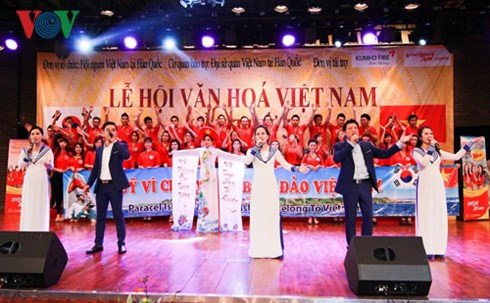
A cultural festival opened Sunday, September 17,in the city of Daejon as part of the celebration of the 25th anniversary of the establishment of diplomatic ties between the Republic of Korea and Vietnam.

Counsellor Tran Anh
Vu from the Vietnam Embassy delivered the opening address at the
event attended by hundreds of local and foreign dignitaries along with members
of the Overseas Vietnamese community.
This year's event covers a diverse spectrum of fields from culture, education,
food, tourism, sports and diplomacy and is the largest in scale that has been
organized so far in celebration of the anniversary of relations between the two
countries, noted Mr Vu.
Many young Vietnamese will participate in the events with an
innovative spirit and we hope that Korean young people will especially
appreciate the cultural heritages and creative endeavours of Vietnam,he added.
It is the Vietnam government’s sincere hope that the upcoming
events will open a new horizon for which Koreans and Vietnamese will be able to
experience each other’s culture through a variety of events.
Opening the festival,
traditional Vietnamese song and dance performance were held to commemorate the
25th anniversary and the food was specially flown in from Vietnam and prepared
by Vietnamese chefs.
Source: VOV
The People’s Committee of Lac Son district held a ceremony on April 28 to receive the provincial relic certificate for the ancient rock carving site at Suoi Co stream, located in My Thanh commune.
A special music show titled "The country is in the fullness of joy” has been held at Hoa Binh Square in Hoa Binh city in celebration of the 50th anniversary of the liberation of the South and national reunification (April 30, 1975–2025).
The People's Committee of Lo Son commune, Tan Lac district, has organised the local annual traditional stream fishing festival on April 19 - 20.
As a land deeply intertwined with human history and Vietnam’s millennia-long journey of nation-building and defence, Hoa Binh is often revered for its epic tales and legends.
Residents of Hoa Binh boast a rich cultural identity, reflected in their unique language, traditional attire, customs, and folk melodies – described as "sweet as honey, clear as a mountain stream.”
Lac Son district’s Vu ban town held the 2025 Truong Kha temple festival on April 12–13 (the 15th–16th days of the third lunar month). Since its revival in 2019, the festival has been organised every three years, preserving valuable intangible heritage while meeting the community’s cultural and spiritual needs.



